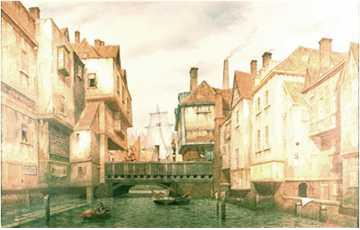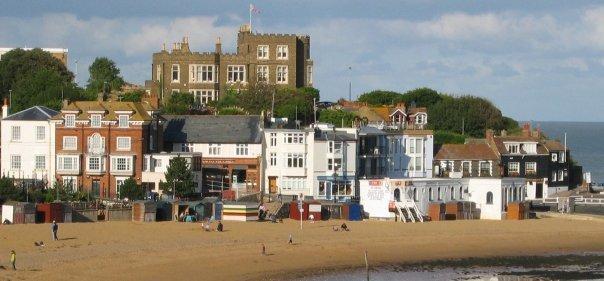|
| | Author | Message |
|---|
Triceratops
Censura

Posts : 4377
Join date : 2012-01-05
 |  Subject: Victorian London Subject: Victorian London  Mon 13 Jan 2014, 12:38 Mon 13 Jan 2014, 12:38 | |
| MM's mention of Dickensian scenes in the Roman London thread, took me onto researching Field Lane/Saffron Hill, the hideout of Fagin in Oliver Twist, when I found this link; http://www.victorianlondon.org/index-2012.htminteresting stuff. |
|   | | Meles meles
Censura

Posts : 5119
Join date : 2011-12-30
Location : Pyrénées-Orientales, France
 |  Subject: Re: Victorian London Subject: Re: Victorian London  Mon 13 Jan 2014, 17:51 Mon 13 Jan 2014, 17:51 | |
| The artist J Stewart in the 1840s produced a series of paintings of the actual locations used by Dickens in his books. The collection is held by the Museum of London. This is his painting of Folly Ditch, Jacob's Island, Bermondsey, which was where Bill Sykes met his end.  Describing the area in 'Oliver Twist' Dickens wrote: "Near to that part of the Thames on which the church at Rotherhithe abuts, where the buildings on the banks are dirtiest and the vessels on the river blackest with the dust of colliers and the smoke of close-built low-roofed houses, there exists the filthiest, the strangest, the most extraordinary of the many localities that are hidden in London, wholly unknown, even by name, to the great mass of its inhabitants.Beyond Dockhead, in the Borough of Southwark, stands Jacob's Island, surrounded by a muddy ditch, six or eight feet deep and fifteen or twenty wide when the tide is in, once called Mill Pond, but known in the days of this story as Folly Ditch. It is a creek or inlet from the Thames, and can always be filled at high water by opening the sluices at the Lead Mills from which it took its old name. At such times, a stranger, looking from one of the wooden bridges thrown across it at Mill Lane, will see the inhabitants of the houses on either side lowering from their back doors and windows, buckets, pails, domestic utensils of all kinds, in which to haul the water up; and when his eye is turned from these operations to the houses themselves, his utmost astonishment will be excited by the scene before him. Crazy wooden galleries common to the backs of half a dozen houses, with holes from which to look upon the slime beneath; windows, broken and patched, with poles thrust out, on which to dry the linen that is never there; rooms so small, so filthy, so confined, that the air would seem to be too tainted even for the dirt and squalor which they shelter; wooden chambers thrusting themselves out above the mud and threatening to fall into it - as some have done; dirt-besmeared walls and decaying foundations, every repulsive lineament of poverty, every loathsome indication of filth, rot, and garbage: all these ornament the banks of Folly Ditch."In Jacob's Island, the warehouses are roofless and empty; the walls are crumbling down; the windows are windows no more; the doors are falling into the streets; the chimneys are blackened, but they yield no smoke. Thirty or forty years ago, before losses and chancery suits came upon it, it was a thriving place; but now it is a desolate island indeed. The houses have no owners; they are broken open, and entered upon by those who have the courage; and there they live, and there they die. They must have powerful motives for a secret residence, or be reduced to a destitute condition indeed, who seek a refuge in Jacob's Island."Here's another Stewart painting ... again of Folly Ditch but this time from the south end looking north past the Mill Lane bridge to the Thames with the chimneys of a lead works and the masts of shipping in the distance (Bermondsey is on the south bank where the river Neckinger, running north and parallel to the Folly Ditch, enters the Thames).  |
|   | | nordmann
Nobiles Barbariæ

Posts : 7223
Join date : 2011-12-25
 |  Subject: Re: Victorian London Subject: Re: Victorian London  Mon 13 Jan 2014, 20:00 Mon 13 Jan 2014, 20:00 | |
| And how it looks now- Jacob Street (just behind the building facing you here) still recalls the Victorian "island" - however the occupants these days have different reasons not to hang out their linen. The old Folly Ditch is now a water feature in this small park and an adjacent one.  |
|   | | Meles meles
Censura

Posts : 5119
Join date : 2011-12-30
Location : Pyrénées-Orientales, France
 |  Subject: Re: Victorian London Subject: Re: Victorian London  Mon 13 Jan 2014, 20:13 Mon 13 Jan 2014, 20:13 | |
| Call me a naive romantic but I think the 1840s tenements had considerable more character! Although I am heartily glad I didn't have to live in them.
PS : And I wish I knew what J Stewart's initial stood for ... I've been trying to find some more of his paintings of places that are mentioned in Dickens' books, but so far without success. |
|   | | Meles meles
Censura

Posts : 5119
Join date : 2011-12-30
Location : Pyrénées-Orientales, France
 |  Subject: Re: Victorian London Subject: Re: Victorian London  Mon 13 Jan 2014, 20:47 Mon 13 Jan 2014, 20:47 | |
| Ah Ha! Got him ..... James Lawson Stewart. From their blurb: The London Museum, now the Museum of London was gifted a large selection of watercolours featuring locations which appeared in Dickens' works in 1934 and a set of cigarette cards was issued by R and J Hill Ltd in 1926 and 1934 entitled Historic Places from Dickens Classics all of which which featured watercolours by Stewart. This is his one of of The Three Cripples Tavern, Little Saffron Hill, Holborn, where Bill Sikes drank.  Dickens described Saffron Hill in Oliver Twist as a densely populated area between Holborn and Clerkenwell: "Thence into Little Saffron Hill, and so into Saffron Hill the Great ... A dirtier or more wretched place he [Oliver] had never seen. The street was very narrow and muddy, and the air was impregnated with filthy odours...The sole places that seemed to prosper around the general blight of the place were the public houses; and in them the lowest order of Irish were wrangling with might and main. Covered ways and yards, which here and there diverged from the main street, disclosed little knots of houses where drunken men and women were positively walking in filth; and from several of the doorways great ill-looking fellows were cautiously emerging, bound, to all appearance, on no very well-disguised or harmless errands."I'd thought Stewart had done his paintings in the 1840s but since he died in 1918 I think that was wrong. This painting is dated circa 1890. It doesn't look too disreputable a place to me so I guess the area had been tidied up since Dickens' day.
Last edited by Meles meles on Tue 14 Jan 2014, 09:42; edited 4 times in total (Reason for editing : and I still got his name wrong it's Lawson not Larson!) |
|   | | nordmann
Nobiles Barbariæ

Posts : 7223
Join date : 2011-12-25
 |  Subject: Re: Victorian London Subject: Re: Victorian London  Mon 13 Jan 2014, 20:49 Mon 13 Jan 2014, 20:49 | |
| Crossed posts but I'll carry on ...
I believe it's James Lawson Stewart, a Southwark lad himself, who became famous mostly for his paintings of London and Edinburgh from around the 1860s onwards.
He was a baker's son and definitely not your typical airy prince of the palette. This from Reynold's Newspaper on July 2nd 1893 when Stewart was 52 years old:
At the Guildhall on Monday, Mr James Lawson Stewart, an artist, residing at Lettson-road, Camberwell, was charged, before Mr. Alderman Morgan, with breaking a plate-glass window in the shop of Mr. John Morris, picture dealer, 5, Crosby-square, Bishopsgate, on Saturday afternoon. Mr. Stewart admitted the facts, but observed that he asked Mr. Morris either to return his pictures or to pay for them. Mr. Alderman Morgan observed that under no circumstances had the defendant any right to break windows. Mr. Morris denied that he owed money to the accused. The Alderman imposed a fine of £3, and ordered the defendant to pay £5 for the damage, or to undergo a month. |
|   | | nordmann
Nobiles Barbariæ

Posts : 7223
Join date : 2011-12-25
 |  Subject: Re: Victorian London Subject: Re: Victorian London  Mon 13 Jan 2014, 20:58 Mon 13 Jan 2014, 20:58 | |
| And a link to the cigarette card collection that used his illustrations of Dickens' locations: James L StewartThis Dickens then and now amazed me. Didn't know it even existed ... Stewart's illustration circa 1875:  And now ...  |
|   | | LadyinRetirement
Censura

Posts : 3324
Join date : 2013-09-16
Location : North-West Midlands, England
 |  Subject: Re: Victorian London Subject: Re: Victorian London  Mon 13 Jan 2014, 21:48 Mon 13 Jan 2014, 21:48 | |
| Previous posters are so right about the change over the years to Jacob's Island .... I was a conveyancing secretary for some years and the firm represented somebody who bought a flat there. Can't recall the price but it was not cheap. It's like [and someone may have mentioned this on a different thread but I can't find it now] but the former match factory in Fairfield Road, E3, - scene of the match girls' 19th century strike and where many employees back then were prone to "Fossie Jaw" as they worked with phosphorous - is now a complex of flats and considered a desirable address. |
|   | | Islanddawn
Censura

Posts : 2163
Join date : 2012-01-05
Location : Greece
 |  Subject: Re: Victorian London Subject: Re: Victorian London  Tue 14 Jan 2014, 05:03 Tue 14 Jan 2014, 05:03 | |
| I was a conveyancing secretary too LIR, it was my first job. Oi oi oi, having to type all those deeds and contracts without making a mistake  . Can't think how I did it now. Sorry off topic, back to London. |
|   | | LadyinRetirement
Censura

Posts : 3324
Join date : 2013-09-16
Location : North-West Midlands, England
 |  Subject: Re: Victorian London Subject: Re: Victorian London  Tue 14 Jan 2014, 10:14 Tue 14 Jan 2014, 10:14 | |
| Conveyancing secretarial work wasn't my first job ID. By the time I became involved computers and word processing programs had come in so there were templates for a lot of the documents and forms on the machine which made life a lot easier. I do admire you for being able to do it the old more difficult way. I did have to do more common or garden secretarial work on the typewriter back in the day. |
|   | | Islanddawn
Censura

Posts : 2163
Join date : 2012-01-05
Location : Greece
 |  Subject: Re: Victorian London Subject: Re: Victorian London  Tue 14 Jan 2014, 11:44 Tue 14 Jan 2014, 11:44 | |
| If only! Word processors and pcs were unheard of back then, but we did have the very latest in technology, electric typewriters. And they did make the job much faster, better by far than banging away on the old Olivettis that we were taught on. |
|   | | Triceratops
Censura

Posts : 4377
Join date : 2012-01-05
 |  Subject: Re: Victorian London Subject: Re: Victorian London  Tue 14 Jan 2014, 13:06 Tue 14 Jan 2014, 13:06 | |
| |
|   | | Triceratops
Censura

Posts : 4377
Join date : 2012-01-05
 |  Subject: Re: Victorian London Subject: Re: Victorian London  Wed 15 Jan 2014, 13:45 Wed 15 Jan 2014, 13:45 | |
| |
|   | | PaulRyckier
Censura

Posts : 4902
Join date : 2012-01-01
Location : Belgium
 |  Subject: Re: Victorian London Subject: Re: Victorian London  Wed 15 Jan 2014, 20:17 Wed 15 Jan 2014, 20:17 | |
| |
|   | | Vizzer
Censura

Posts : 1851
Join date : 2012-05-12
 |  Subject: Re: Victorian London Subject: Re: Victorian London  Sun 03 Jan 2021, 20:30 Sun 03 Jan 2021, 20:30 | |
| - nordmann wrote:
- This Dickens then and now amazed me. Didn't know it even existed ...
Stewart's illustration circa 1875:

And now ...
 It should be appreciated that the shop in London's Portsmouth Street only changed its name to 'The Old Curiosity Shop' after the publication of Charles Dicken's novel. There is a counter tradition in East Kent which suggests that (although the book is indeed set in London) Charles actually drew inspiration for his story from an antique shop in Broadstairs. And in the Thanet town there is indeed an antiquarian tea-room called 'The Old Curiosity Shop' which is housed in an 18th Century building but that too is widely believed to be a clever tourist trap merely cashing in on the town's many Dickens connections. Another Dickens connected building (although with more proven reason because Charles actually holidayed there) is Fort House which overlooks the town. So strong is the connection, that it has subsequently changed its name to 'Bleak House' so that any tourist on the literary trail will be under no illusion as to its identity. A rather needy decision on the part of the owners, in my opinion, as the splendid residence features prominently on any painting, postcard or photograph of the town and always looks anything but bleak.  (Fort House 'Bleak House', Broadstairs in a view virtually unchanged since in the mid-19th Century when Dickens stayed there.) |
|   | | Sponsored content
 |  Subject: Re: Victorian London Subject: Re: Victorian London  | |
| |
|   | | |
Similar topics |  |
|
| | Permissions in this forum: | You cannot reply to topics in this forum
| |
| |
| |
